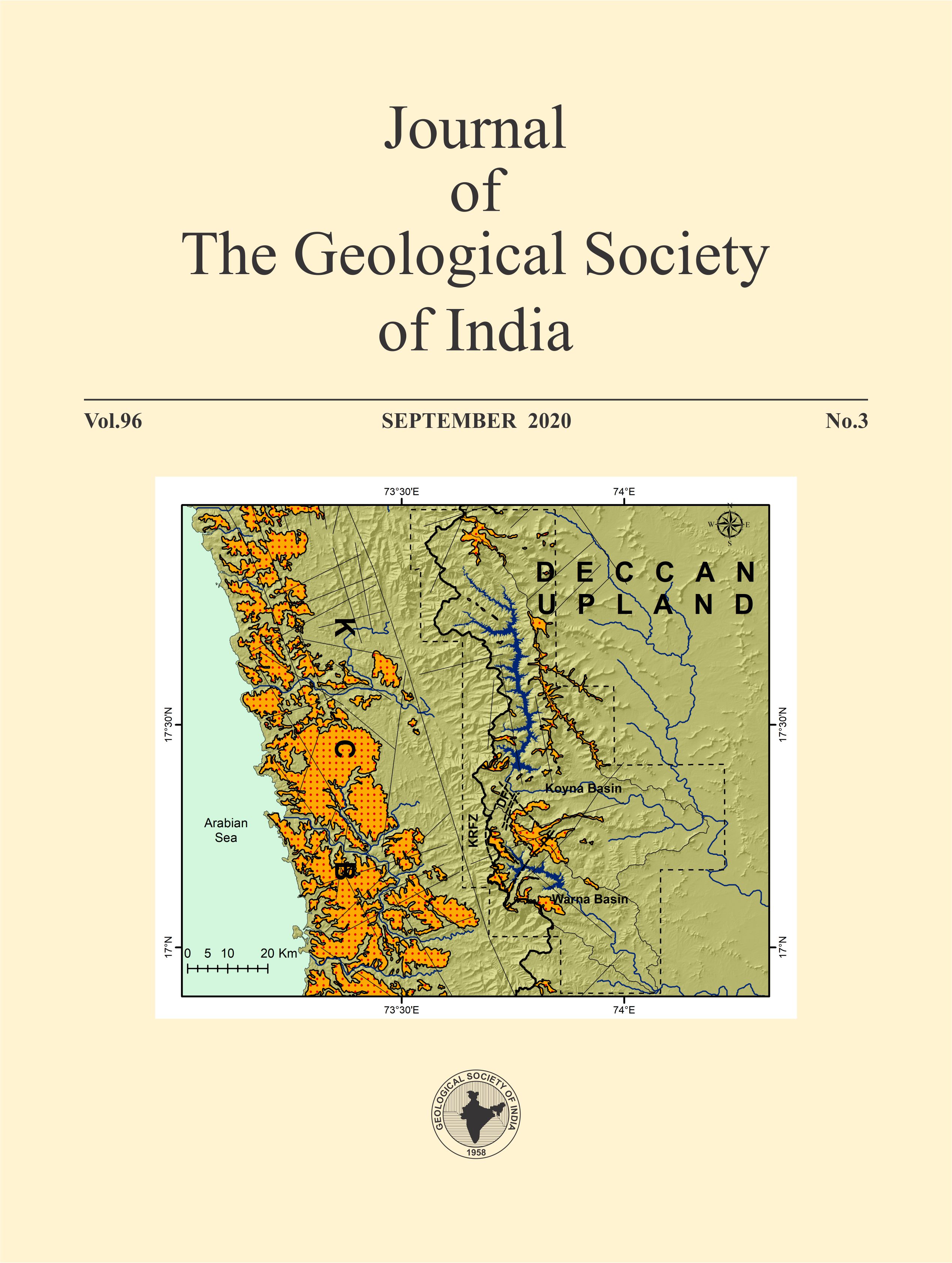Rock Mass Characterization for the Underground Surge Pool Cavern – A Case Study, India
DOI:
https://doi.org/10.1007/s12594-020-1546-5Abstract
Underground surge pool cavern for the storage and lifting of water is being constructed in the part of Telangana State of India. For better rock mass characterization and support design, 3D engineering geological mapping was carried for the heading portion of the surge pool. 3D geologic mapping of heading portion is very important for large underground cavern to know about the cavern behavior during benching down. The direction of the longest axis of the cavern was finalized based on the in-situ hydrofracturing testing inside the deep borehole. The assessment of tunnel quality index ‘Q' for the exposed granitic rock mass was done based on the information available of the rock joints and their nature, 3D geological mapping and in-situ stress measurement. Roof support and wall support pressure was estimatedbased on Q-values, and in this case applicable for the non-squeezing ground condition. For structural stability of crown and walls, rock support arrangement was recommended based on NMT technology and geological conditions of site, which includes steel fibre reinforced shotcrete, grouting, rock bolt and drainage hole provisions. The capacity of support system is determined to evaluate the efficacy of the proposed support system.Downloads
Metrics
Issue
Section
Downloads
Published
How to Cite
References
Anon (2017) Report on determination of in-situ stress parameters at the proposed underground surge pool of Palamuru Rangareddy lift irrigation scheme lift-III-pumping station. Unpubld. NIRM Report No. GE1704C, 22p.
Barton, N., Lien, R. and Lunde, J. (1974) Engineering classification of rock masses for the design of tunnel support. Rock Mechanics, v.6(4), pp.189– 236.
Barton, N.,Loset, F., Lien, R. and Lunde, J. (1980) Application of the Q-system in design decisions concerning dimensions and appropriate support for underground installations. In International Conference on Sub-surface Space, Rock Store, Stockholm, Sub-Surface Space, v.2, pp. 553–561.
Bieniawski, Z.T. (1989) Engineering rock mass classification, John Willey and Sons, New York, 251p.
Grimstad, E. and Barton, N. (1993) Updating of the Q-system for NMT. In: Proceedings of the International Symposium on Sprayed Concrete, Fagernes, Oslo, pp.46-66.
Grimstad, E., Kankes, K.,Bhasin, R., Magnussen, A. and Kaynia, A. (2002) Rock mass quality Q used in designing reinforced ribs of sprayed concrete and energy absorption. In: Proceedings of the International Symposium on Sprayed Concrete, Davos, pp.134-142.
GSI (1995) Geological Quadrangle maps of GSI: No. 57E (2004) and 56L (1995) published by Geological Survey of India.
IS, 13365-Part 2 (1992) Quantitative classification systems of rock mass – guidelines, Part-2, Rock mass quality for prediction of support pressure in underground openings. Bureau of Indian Standards, New Delhi, 8p.
IS 15026 (2002) Tunnelling methods in rock masses – guidelines, Bureau of Indian Standards, New Delhi, 26p.
Nagarajan, K. and Roy, M.D. (1991) Geology of Peninsular Gneissic Complex in parts of Mahabubnagar District, Andhra Pradesh, Rec. Geol. Sur. India, v.124 (5), pp. 15-17.
Naithani, A.K. (2017) Geotechnical investigations and support design of underground pump house cavern – acase study from lift irrigation project. Internat. Jour. Geotech. Geol. Engg., v.35(5), pp.2445-2453.
Naithani, A.K., Singh, L.G. and Jain Prasnna (2017). Rock mass characterization and support design for underground additional surge pool cavern – a case study, India. Geomaterials, v.7, pp.64-82.
Naithani, A.K., Rawat, D.S., Jain, P. Singh, L.G., Srisailam, M. and Venkatramaiah, V. (2019) Rock mass characterization and support system for underground pump house cavern – a case study, India. In: Proceedings 14th International Conference on Underground Construction Prague 2019, paper no. S4-OP7, pp.1-9.
NGI (2013) Using the Q-system – rock mass classification and support design. NGI Publication, Norway, 54p.
Prakash, D. and Sharma, I.N. (2011) Metamorphic evolution of Karimnagar granulite terrane, Eastern Dharwar Craton, South India. Geol. Magz., v.48, pp.112-132.
Ramam, P.K. and Murty, V.N. (2012) Geology of Andhra Pradesh. Geological Society of India, Bangalore, 244p.
Reddy, G.T. and Rao V.N. (1991) Study of granitic rocks in Gadwal Makhtal area, Mahbubnagar District, Andhra Pradesh. Rec. Geol. Surv. India, v.124(5), pp.256-258.
Sharma, R., Murthy, C.V.V.S., Mishra, V.P., Nagaraju, Gouda, H.C. and Singh, R.K. (2008) Study of structural pattern through aeromagnetic data for mineral prospecting and Kimberlite clan rocks in an area around Mahbubnagar, A.P. Jour. Geol. Soc. India, v.72, pp.175-189.
Singh, B., Jethwa, J.L., Dube, A.K. and Singh, B. (1992) Correlation between observed support pressure and rock mass quality. Tunnelling and Underground Space Technology, v.7(1), pp.59-74.
Singh, B.,Viladkar, M.N. and Samadhiya, N.K. (1995) A semi-empirical method of the design of support systems in underground openings. Tunnelling and Underground Space Technology, v.3, pp.375-383.
Singh, B. and Goel, R.K. (2011) Engineering rock mass classification, Elsevier Inc. Publication, U.K, 364p.
Sridhar, M., Chowdhary, V.S., Nayak, S.S. and Augastine, P.F. (2004) Discovery of Kimberlite pipes in Gadwal area Mahabubnagar District. Jour. Geol. Soc. India, v.63(1), pp.95-99.
Stillborg, B. (1994) Professional users handbook for rock bolting. Trans. Tech. Publn., Germany, 164p.

 A. K. Naithani
A. K. Naithani






